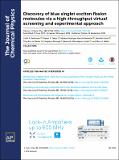| dc.contributor.author | Perkinson, Collin Fisher | |
| dc.contributor.author | Tabor, Daniel P. | |
| dc.contributor.author | Einzinger, Markus | |
| dc.contributor.author | Sheberla, Dennis | |
| dc.contributor.author | Utzat, Hendrik | |
| dc.contributor.author | Lin, Ting-An | |
| dc.contributor.author | Congreve, Daniel N. | |
| dc.contributor.author | Bawendi, Moungi G | |
| dc.contributor.author | Aspuru-Guzik, Alán | |
| dc.contributor.author | Baldo, Marc A. | |
| dc.date.accessioned | 2020-06-23T20:34:46Z | |
| dc.date.available | 2020-06-23T20:34:46Z | |
| dc.date.issued | 2019-09 | |
| dc.date.submitted | 2019-06 | |
| dc.identifier.issn | 0021-9606 | |
| dc.identifier.uri | https://hdl.handle.net/1721.1/125962 | |
| dc.description.abstract | Singlet exciton fission is a mechanism that could potentially enable solar cells to surpass the Shockley-Queisser efficiency limit by converting single high-energy photons into two lower-energy triplet excitons with minimal thermalization loss. The ability to make use of singlet exciton fission to enhance solar cell efficiencies has been limited, however, by the sparsity of singlet fission materials with triplet energies above the bandgaps of common semiconductors such as Si and GaAs. Here, we employ a high-throughput virtual screening procedure to discover new organic singlet exciton fission candidate materials with high-energy (>1.4 eV) triplet excitons. After exploring a search space of 4482 molecules and screening them using time-dependent density functional theory, we identify 88 novel singlet exciton fission candidate materials based on anthracene derivatives. Subsequent purification and characterization of several of these candidates yield two new singlet exciton fission materials: 9,10-dicyanoanthracene (DCA) and 9,10-dichlorooctafluoroanthracene (DCOFA), with triplet energies of 1.54 eV and 1.51 eV, respectively. These materials are readily available and low-cost, making them interesting candidates for exothermic singlet exciton fission sensitization of solar cells. However, formation of triplet excitons in DCA and DCOFA is found to occur via hot singlet exciton fission with excitation energies above ∼3.64 eV, and prominent excimer formation in the solid state will need to be overcome in order to make DCA and DCOFA viable candidates for use in a practical device. | en_US |
| dc.description.sponsorship | U.S. Department of Energy, Office of Science, Office of Basic Energy Sciences (grant no. DE-SC0001088) | en_US |
| dc.language.iso | en | |
| dc.publisher | AIP Publishing | en_US |
| dc.relation.isversionof | 10.1063/1.5114789 | en_US |
| dc.rights | Creative Commons Attribution 4.0 International license | en_US |
| dc.rights.uri | https://creativecommons.org/licenses/by/4.0/ | en_US |
| dc.source | The Journal of Chemical Physics | en_US |
| dc.title | Discovery of blue singlet exciton fission molecules via a high-throughput virtual screening and experimental approach | en_US |
| dc.type | Article | en_US |
| dc.identifier.citation | Perkinson, Collin Fisher, et al., "Discovery of blue singlet exciton fission molecules via a high-throughput virtual screening and experimental approach." Journal of Chemical Physics 151 (Sept. 2019): no. 121102 doi 10.1063/1.5114789 ©2019 Author(s) | en_US |
| dc.contributor.department | Massachusetts Institute of Technology. Department of Chemistry | en_US |
| dc.relation.journal | Journal of Chemical Physics | en_US |
| dc.eprint.version | Final published version | en_US |
| dc.type.uri | http://purl.org/eprint/type/JournalArticle | en_US |
| eprint.status | http://purl.org/eprint/status/PeerReviewed | en_US |
| dc.date.updated | 2019-12-12T17:41:43Z | |
| dspace.date.submission | 2019-12-12T17:41:45Z | |
| mit.journal.volume | 151 | en_US |
| mit.metadata.status | Complete | |

